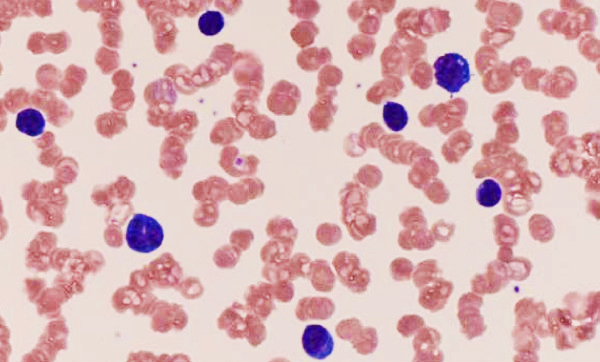WBR0785
| Author | [[PageAuthor::Rim Halaby, M.D. [1]]] |
|---|---|
| Exam Type | ExamType::USMLE Step 1 |
| Main Category | MainCategory::Pathophysiology |
| Sub Category | SubCategory::Oncology |
| Prompt | [[Prompt::A 69 year old man is being worked up for recent onset renal insufficiency. As part of his work-up his nephrologist orders a blood smear with a photomicrograph presented below. Which of the following conditions can explain the patient’s findings? |
| Answer A | AnswerA::Hairy cell leukemia |
| Answer A Explanation | AnswerAExp::Hairy cell leukemia is not associated with rouleaux formation on peripheral smear. Typical findings include lymphocytes with irregular hair-like borders. |
| Answer B | AnswerB::Chronic lymphocytic leukemia |
| Answer B Explanation | AnswerBExp::CLL is not associated with rouleaux formation on peripheral smear. |
| Answer C | AnswerC::Hemolytic uremic syndrome |
| Answer C Explanation | AnswerCExp::HUS is not associated with rouleaux formation on peripheral smear. Schistocytes can usually be found. |
| Answer D | AnswerD::Disseminated intravascular coagulopathy |
| Answer D Explanation | AnswerDExp::DIC is not associated with rouleaux formation on peripheral smear. Schistocytes can also be found in DIC. |
| Answer E | AnswerE::Multiple myeloma |
| Answer E Explanation | AnswerEExp::MM is usually associated with rouleaux formation on peripheral smear due to the associated hypergammaglobulinemia. |
| Right Answer | RightAnswer::E |
| Explanation | [[Explanation::Multiple myeloma is a malignant plasma cell proliferation clincially characterized by anemia, bone pain, and renal insufficiency. Diagnosis is usually supported by multiple tests including serum and urine assays for monoclonal protein M spike, light chain assays, serum Beta-2-microglobulin, bone marrow biopsy, and skeletal imaging. A classical finding of multiple myeloma on peripheral smear is rouleaux formation of red blood cells due to the aggregation with serum paraproteins. Other diseases with elevated serum proteins can exhibit rouleaux formation although MM is a classical example tested on board examinations.
San miguel JF, Gutiérrez NC, Mateo G, Orfao A. Conventional diagnostics in multiple myeloma. Eur J Cancer. 2006;42(11):1510-9. |
| Approved | Approved::No |
| Keyword | WBRKeyword::Multiple myeloma, WBRKeyword::Rouleaux |
| Linked Question | Linked:: |
| Order in Linked Questions | LinkedOrder:: |
